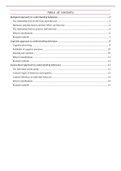Summary
Summary IB Psychology SL SAQs Exam Revision
- Course
- Institution
Short revision document for IB Psychology SL short answer questions. Contains example question, brief theory on the topic and an example study (study not summarised) in table format.
[Show more]



